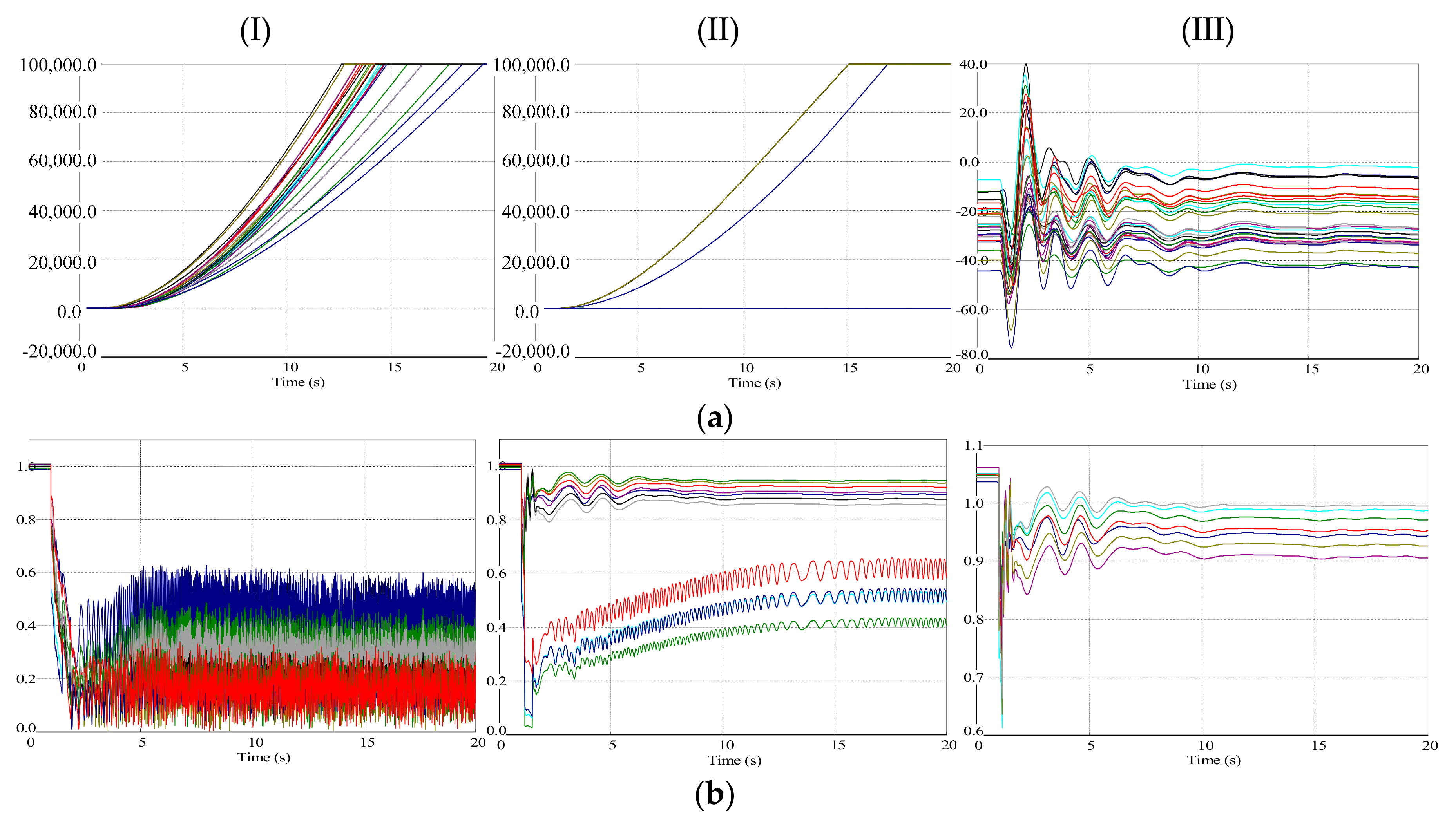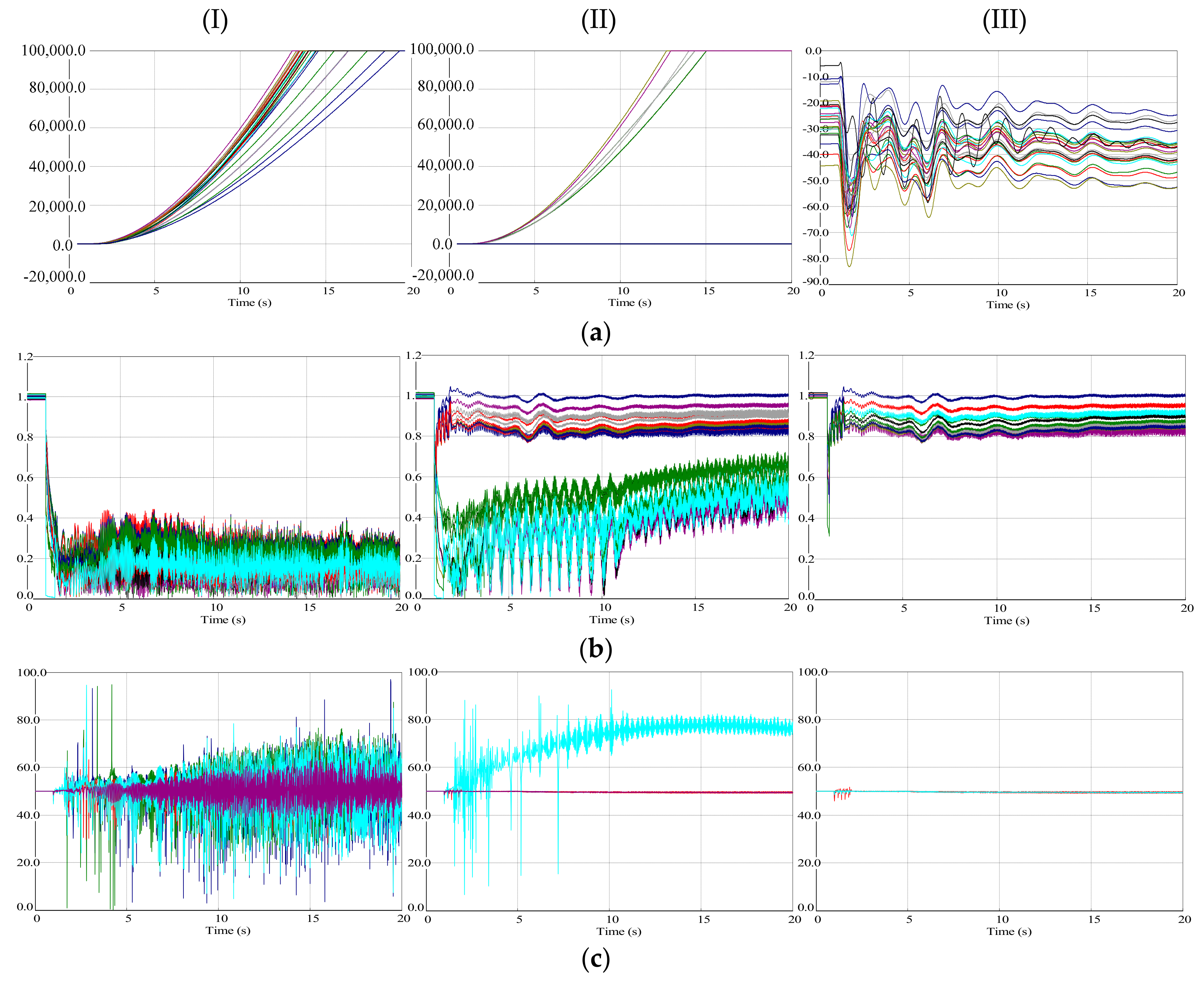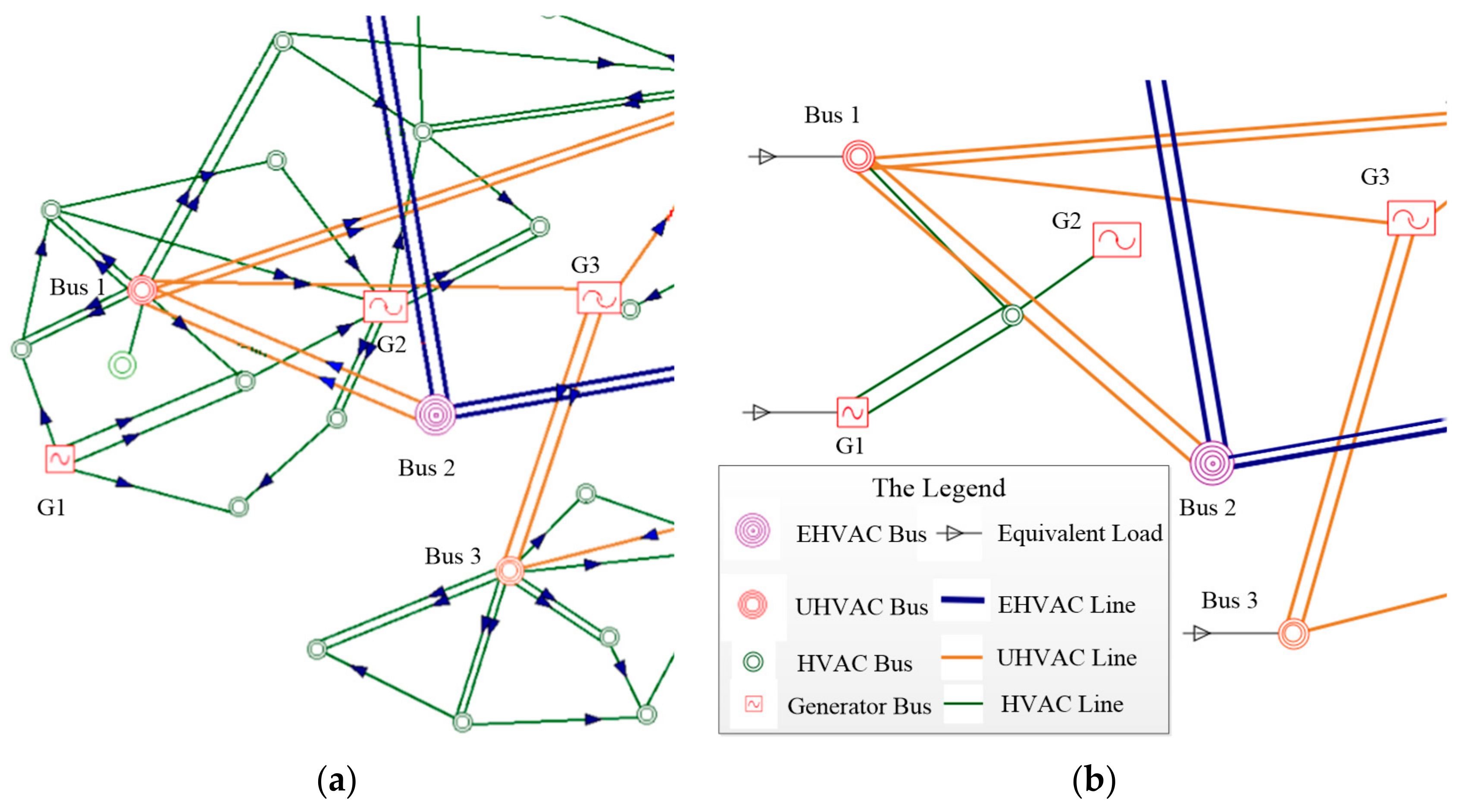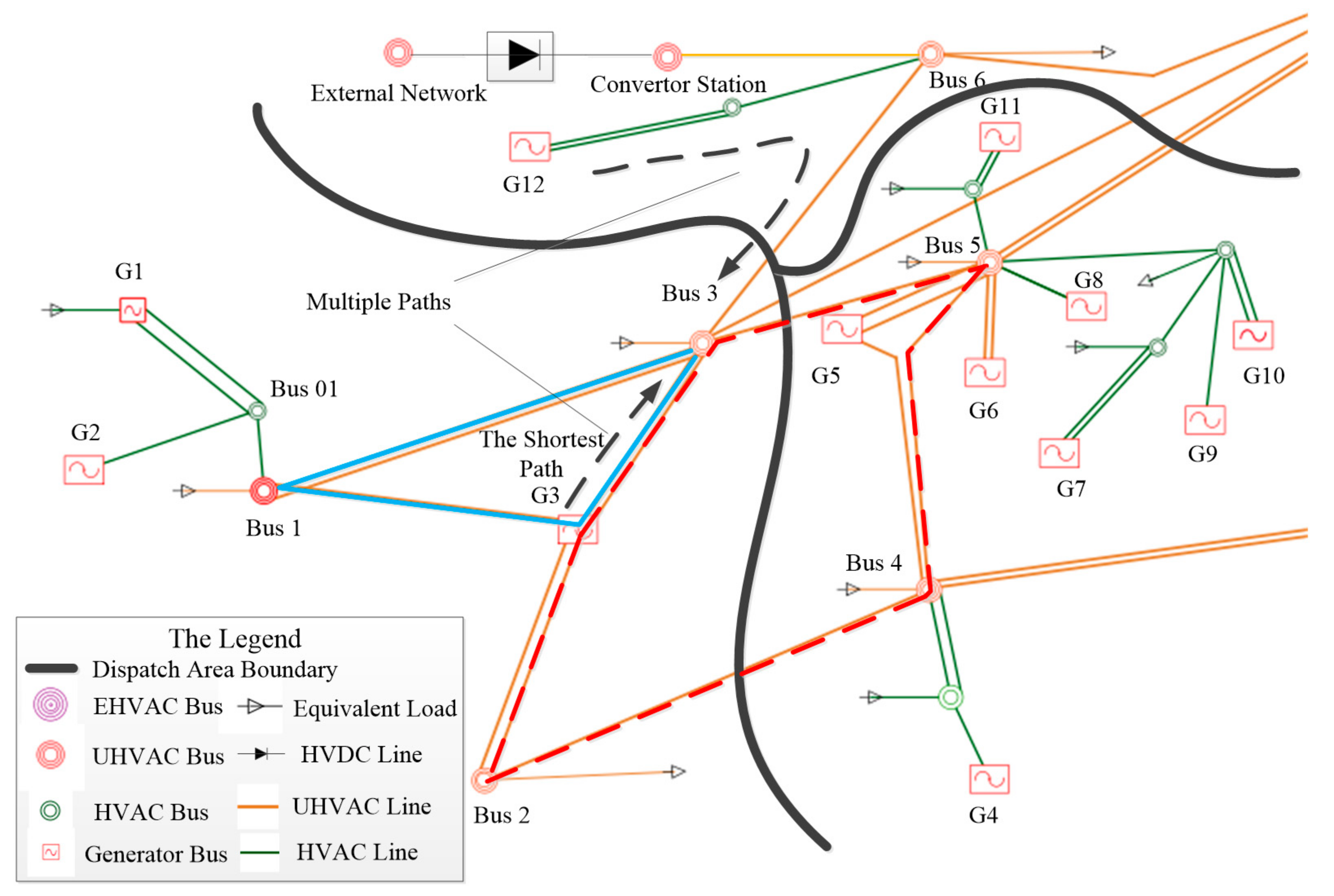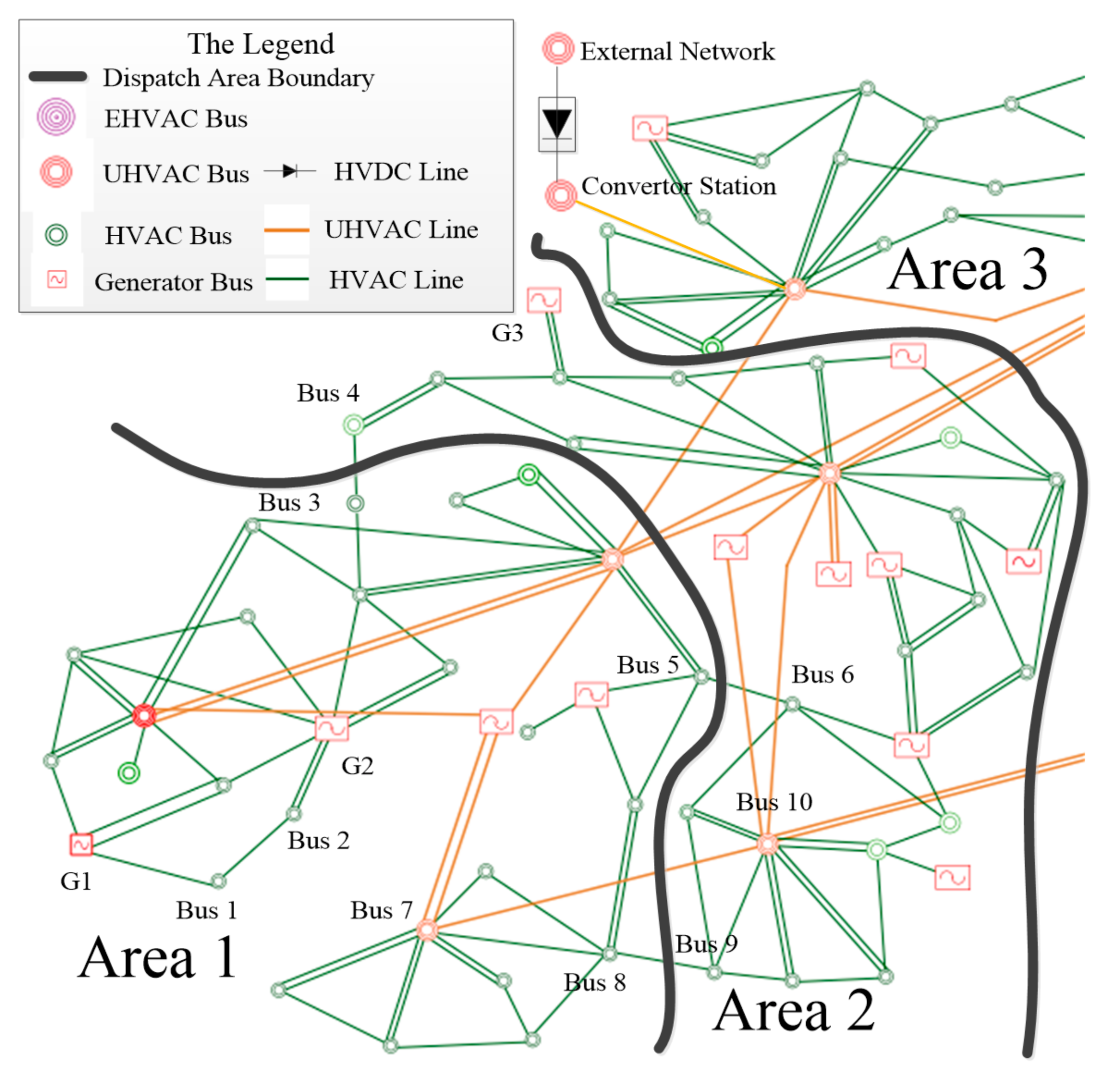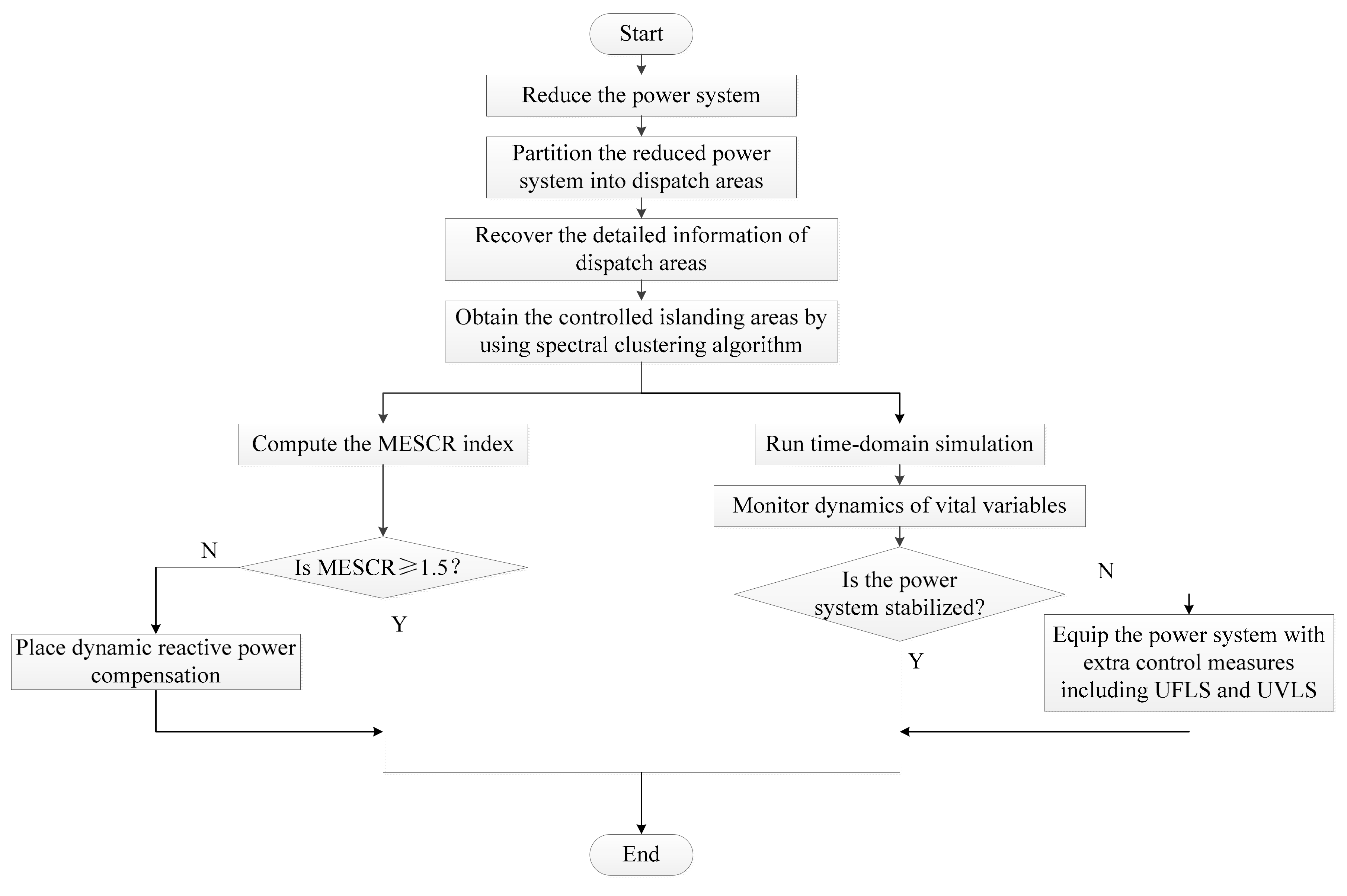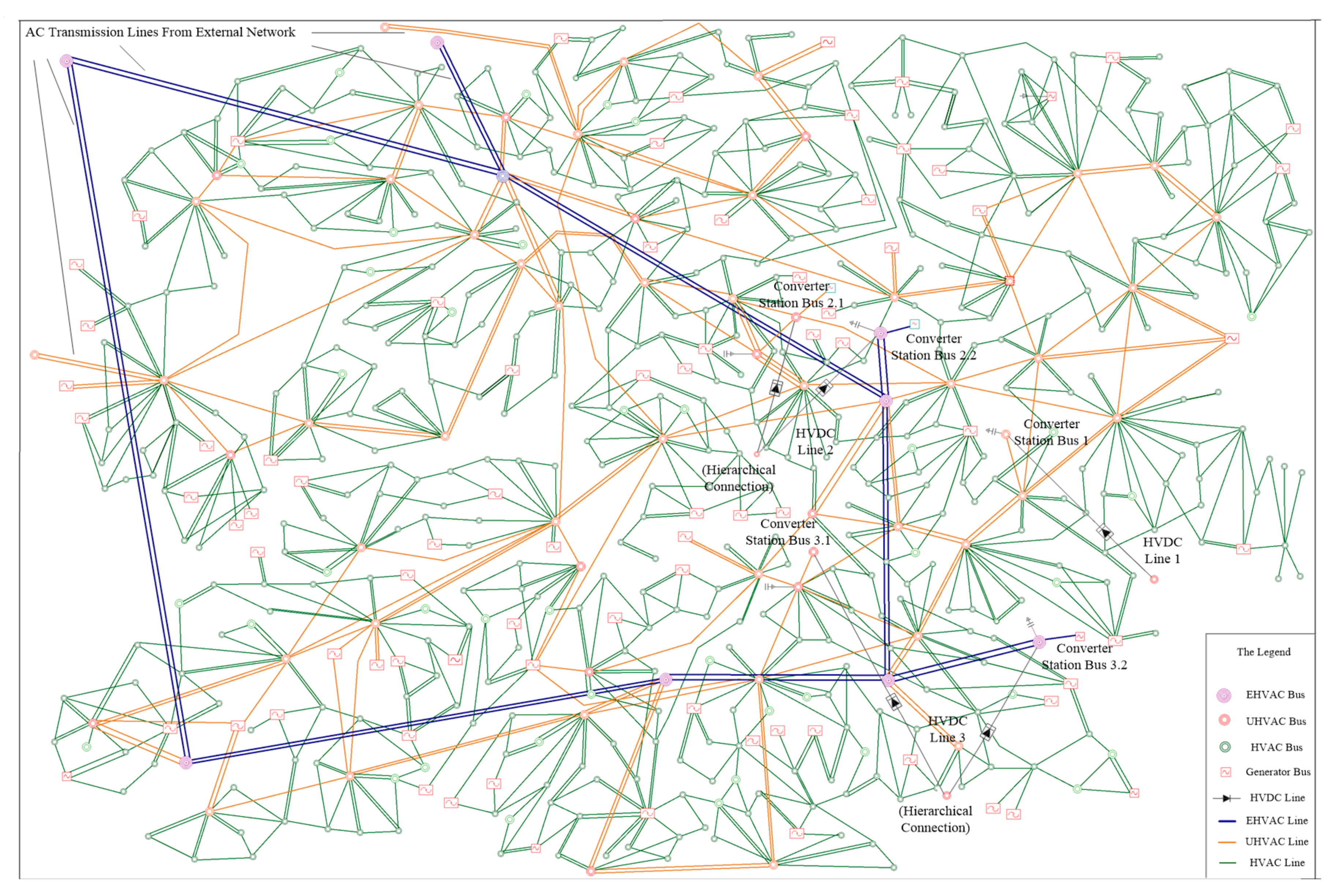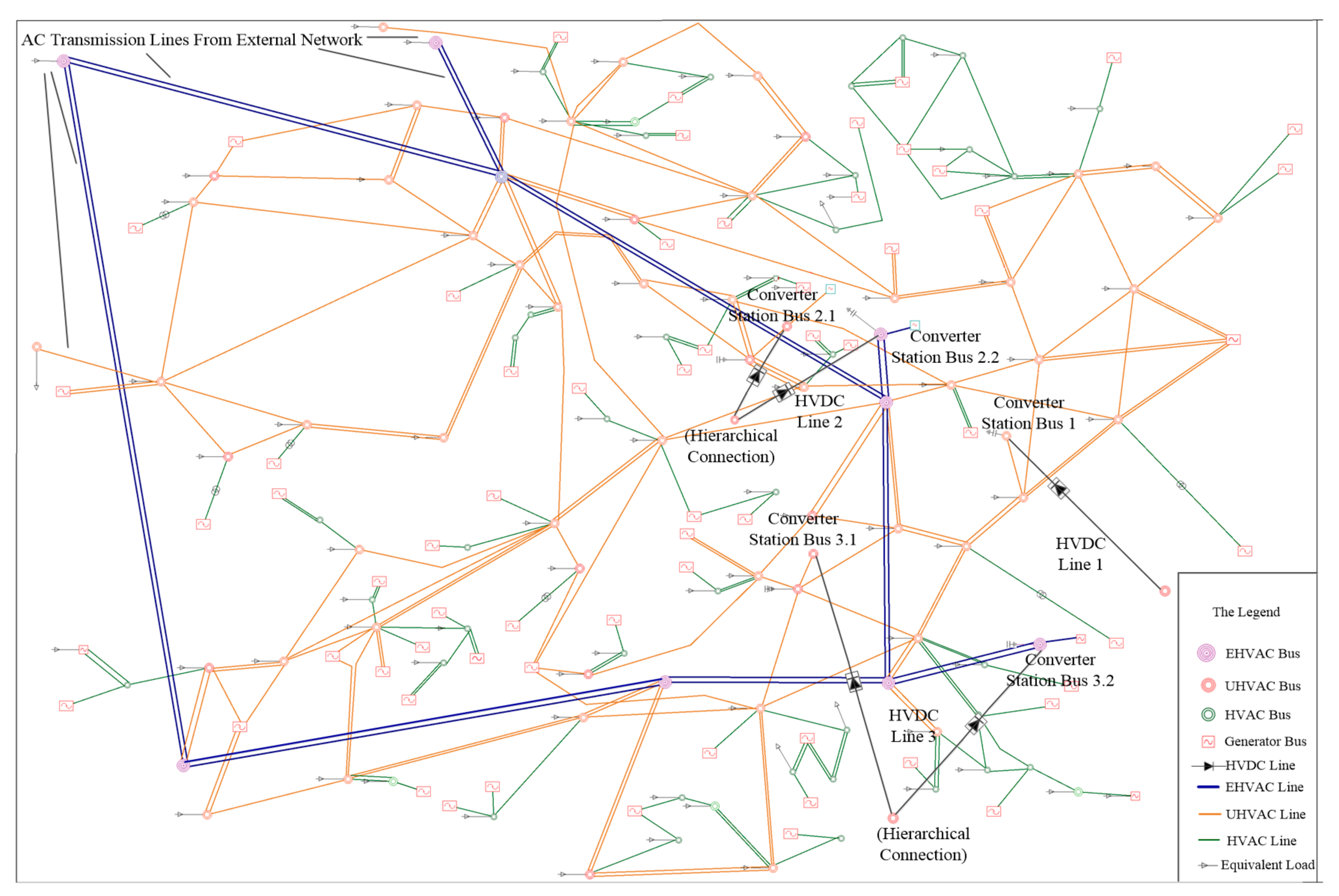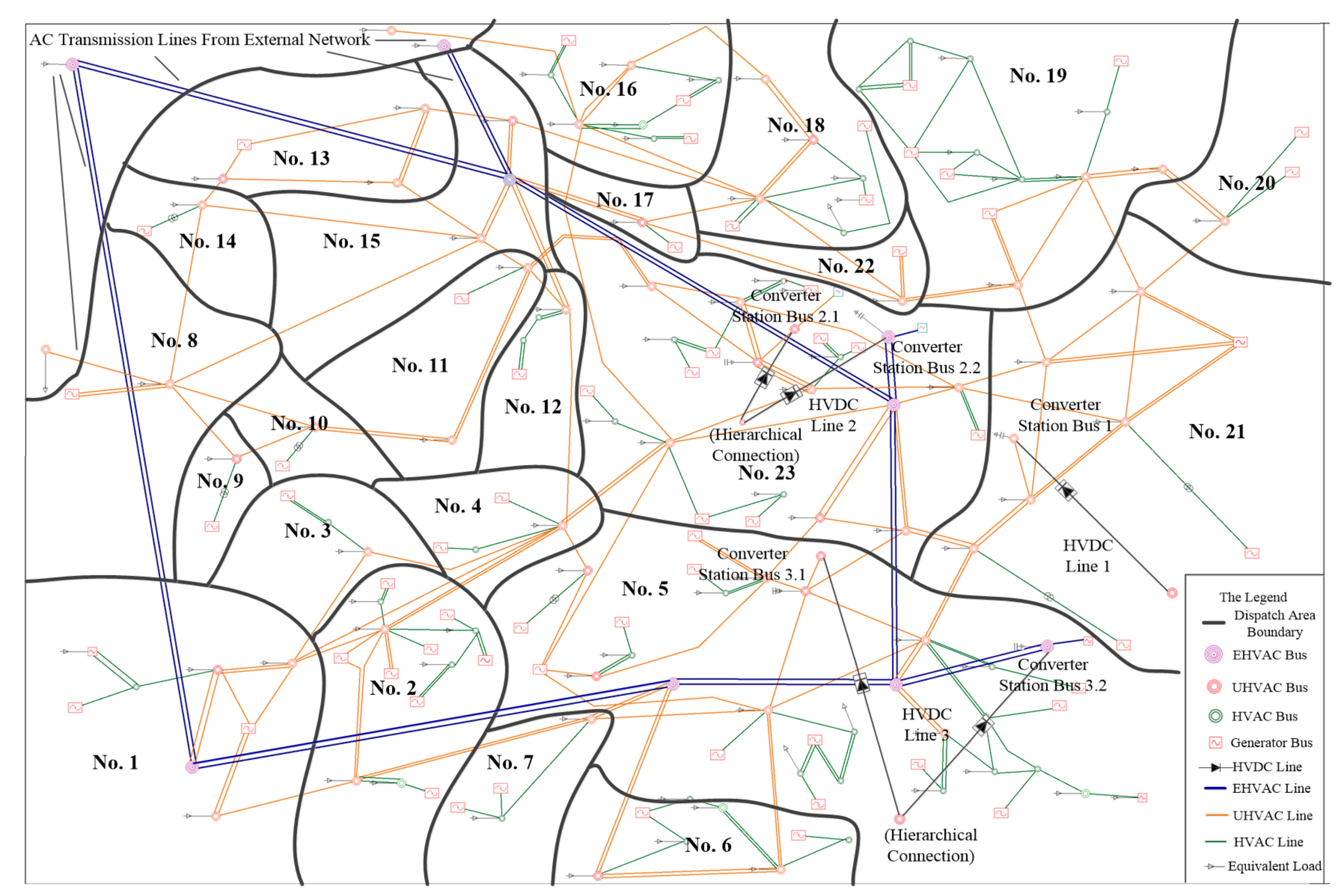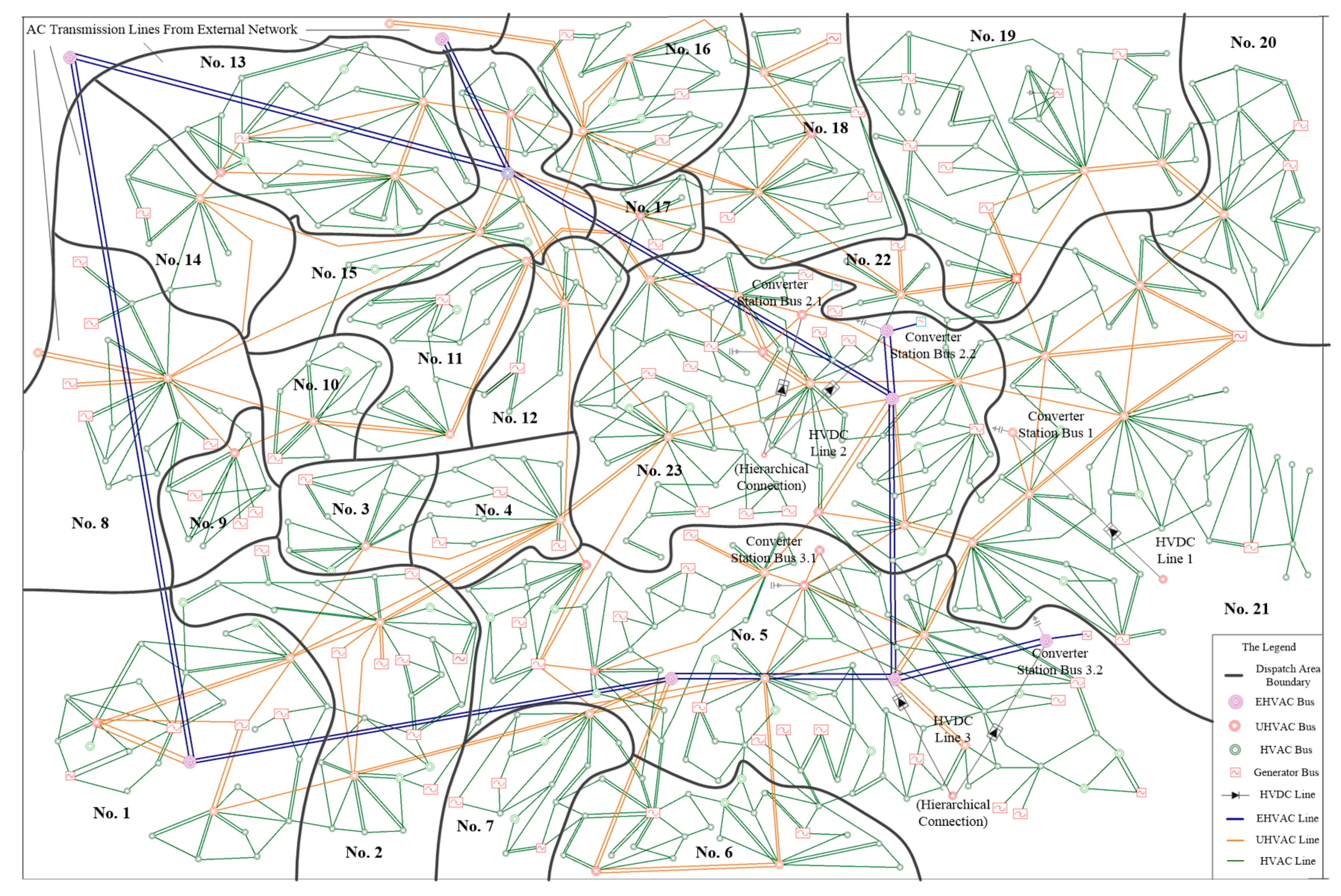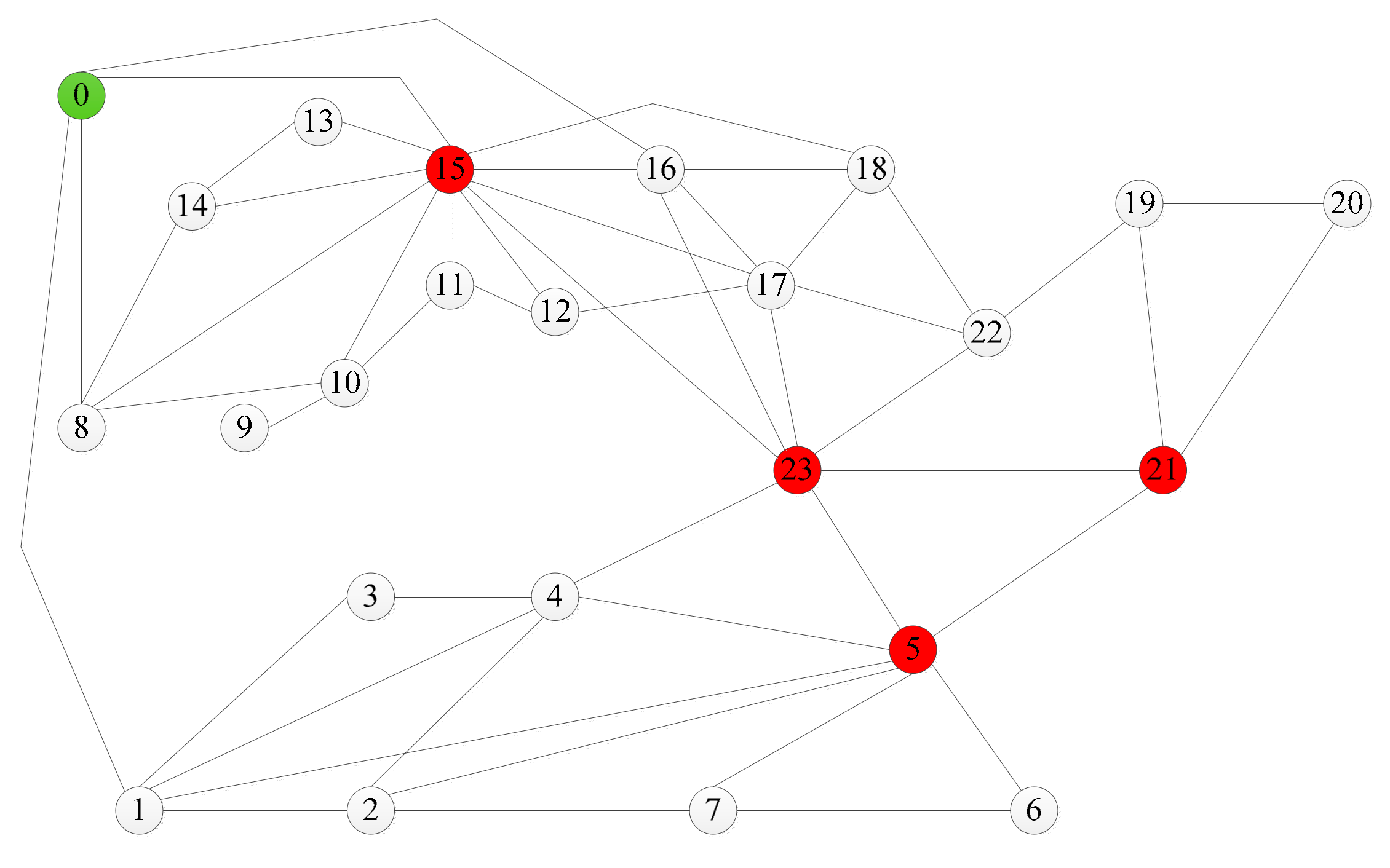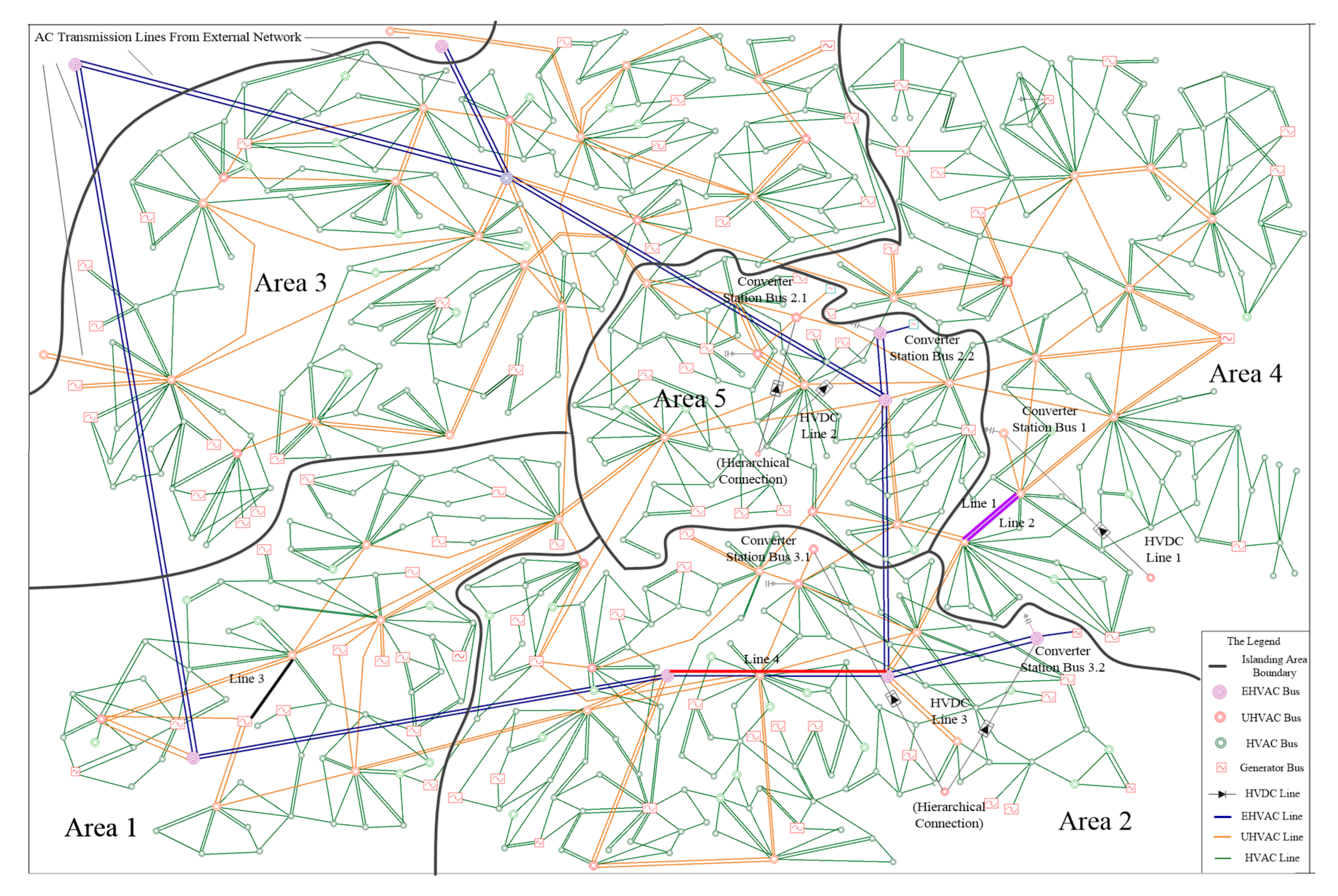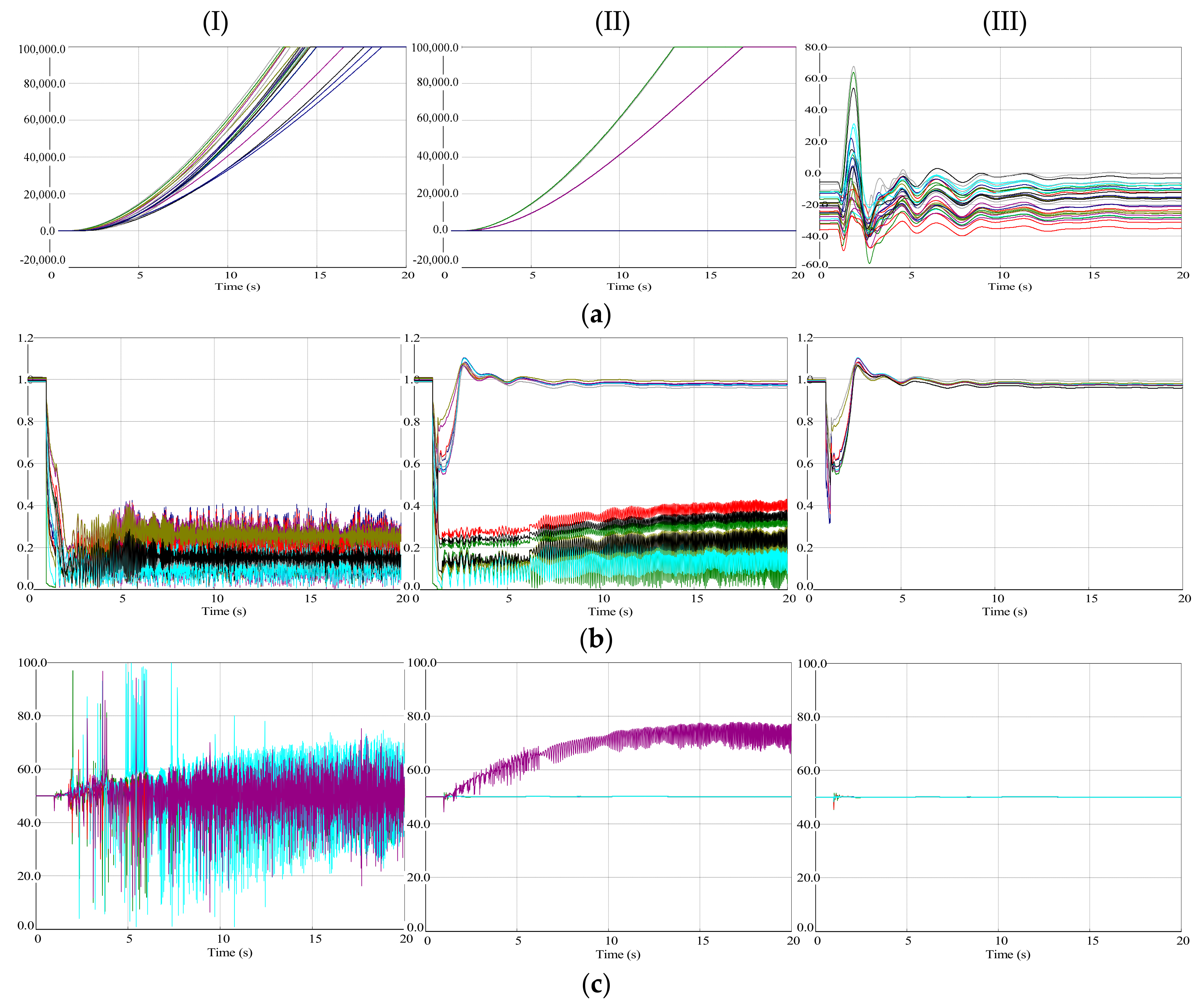3.1. Controlled Islanding Using Spectral Clustering Algorithm
Dispatch areas obtained in
Section 2 are candidates of controlled islanding areas. Nevertheless, the number of dispatch areas is too large, which will pose a great monitoring and control burden for the system operator. Besides, the coverage of each islanding area should be appropriately set to limit the impact of extremely serious faults. Therefore, the total number of islanding areas cannot be too small. The appropriate number of controlled islanding areas should be determined in accordance with the structural scale of the actual system.
Spectral clustering is a widely used clustering algorithm which is more adaptive to the distribution of data than the traditional K-means algorithm [
28]. Spectral clustering is used to partition volt/VAR control areas in bulk power systems in [
29]. The power system is partitioned to solve distributed optimal power flow by employing the spectral clustering algorithm in [
30]. The spectral clustering algorithm has been applied to the out-of-step islanding in [
31,
32,
33,
34]. In this paper, controlled islanding areas are obtained through clustering dispatch areas by using the spectral clustering algorithm.
The dispatch areas are treated as vertexes while the transmission lines between any two dispatch areas are treated as undirected edges. Thus, the power system is expressed with an undirected weight graph
G (
V0,
E0) with vertex set
V0 and edge set
E0. The search of islanding areas can be transformed into the search of the appropriate cut-sets of the undirected weight graph. The elements in the neighboring weights matrix
W of
G (
V0,
E0) are:
where
wij is the weight of the edge (
i,
j); the larger
wij is, the higher the similarity between
i and
j, and the closer the connection between these two vertexes.
The weight of
wij is determined by the number of and active power transferred on the transmission lines of the boundary between dispatch areas
i and
j as:
where
lij is the number of transmission lines between dispatch area
i and
j,
lmax is the biggest number of transmission lines of the boundary between any two dispatch areas,
Pij is the active power transferred on transmission lines between dispatch area
i and
j, and
Pmax is the largest active power on transmission lines of the boundary between any two dispatch areas. Note that any two dispatch areas which contain the buses from sets A and B (as mentioned in
Section 2.2) should not be clustered into the same islanding area. Hence, the weight of
wij should be set to 0 for the corresponding dispatch areas
i and
j.
As shown in (5), the degree matrix
D is generated based on
W. The Laplacian matrix is calculated based on
D and
W, as in (6). The standardized Laplacian matrix is expressed as in (7).
The eigenvectors corresponding to the smallest
K eigenvalues of
L′ are used to compose the matrix
V as:
where
K is the number of clusters. Each row of
V is treated as a sample for clustering.
K samples are chosen as the original cluster centers. In each iteration, the Euclidean distances between the cluster centers and the other samples are calculated. Each sample is assigned to the cluster that is of the shortest distance between its center and the sample compared with other clusters. Each cluster center is updated by averaging samples of the cluster. The iteration process will repeat until it converges or reaches the preset maximum number.
By using the spectral clustering algorithm, the controlled islanding areas are obtained through clustering the dispatch areas. The dispatch areas connecting closely with each other are gathered into an islanding area. Transmission lines intersecting the islanding boundaries, i.e., the cut-sets among islanding areas, should be equipped with devices for controlled islanding.
Once the integrity of the power system cannot be maintained with extremely serious faults occurring and propagating, cut-sets between the emergent areas that are most greatly impacted by the faults and the other areas will be tripped to isolate the emergent areas. Supplementary measures should be implemented to complement the controlled islanding, which include generator tripping, under frequency load shedding (UFLS), under voltage load shedding (UVLS), etc. The controlled islanding is usually followed by the restoration procedure.
Note that the controlled islanding strategy proposed is implemented in a centralized way, which is compatible with the operating practices of a synchronous power system. The AC/DC power systems are operated synchronously with the structural integrity maintained in normal conditions. Whenever the controlled islanding strategy is actuated, the islanding areas are to be centrally monitored and controlled by the system operator. The islanding areas will be re-synchronized when the synchronism conditions can be met.
3.2. Verification of Controlled Islanding Strategy
Verification of the controlled islanding strategy is required to test its feasibility, efficacy, and adaptability for the power system on which the islanding strategy is to be implemented. Certain indices describing steady-state characteristics of the system are computed to verify the feasibility of the islanding strategy, e.g., whether the structural strength of the system after islanding is sufficient to tolerate the complicated interactions between AC and DC subsystems. A series of simulations accounting for various operating conditions are conducted to assess the dynamic performance of the system, which demonstrate the efficacy and adaptability of the islanding strategy to prevent the system from further deterioration and stabilize it.
It is of great importance to evaluate the structural strength of the power system since it reflects the capability of the AC system to support the normal operation of DC lines. Various indices have been proposed to depict the structural strength of a power system. The multi-infeed short circuit ratio (MSCR) is usually used to evaluate the strength of a system with multi-infeed DC lines [
24,
25,
26]. The multi-infeed effective short circuit ratio (MESCR) is proposed as the modification of the MSCR, which accounts for the reactive power compensation at converter station buses. The MESCR is defined as:
where Si is the short-circuit capacity at the converter station bus i; |Pdi| and |Pdj| are the rated power of the ith and jth DC lines, respectively; MIIFji is the multi-infeed interaction factor depicting the impact of the jth DC line on the ith one; and Qi is the capacity of reactive compensation at bus i.
The larger the value of the MESCR index is, the stronger the structural strength of the power system is. A commonly used criterion is as follows. For a strong system, MESCR ≥ 2.5; for a weak system, 1.5 ≤ MESCR < 2.5; for an extremely weak system, MESCR < 1.5. According to the criterion, the MESCR value of each converter station bus should be at least greater than or equal to 1.5 after controlled islanding. If not, the strength of the system should be enhanced through effective measures including the implementation of dynamic reactive power compensation such as the synchronous compensator (SC), static Var compensator (SVC), static synchronous compensator (STATCOM), etc.
The dynamic performance of the power system should be assessed by running time-domain simulations to verify that the system is capable of surviving the extremely serious faults through implementing the controlled islanding strategy. Although the original power system is first reduced to decrease the computational complexity, the time-domain simulations are actually conducted for the whole detailed system. Dynamics of vital variables are monitored, which depict the evolving states of the system. Rotor angles of major generators are extracted to reflect the synchronization of the system. Voltages of end buses on cut-sets of islanding areas are used to assess the voltage stability. The system frequency is monitored to depict the real-time active power balance between generation and load. Dynamic variables of DC lines are employed to reflect their operating states.
The fault of DC lines will usually pose great impacts on the hybrid AC/DC system since a large amount of power is transferred through the DC lines. For the applicability of the controlled islanding strategy, extra control measures including UFLS and UVLS should be activated to maintain the power balance. In very rare cases, if the evolvement of extremely serious faults cannot even be halted by the controlled islanding, other more aggressive measures should be taken.
